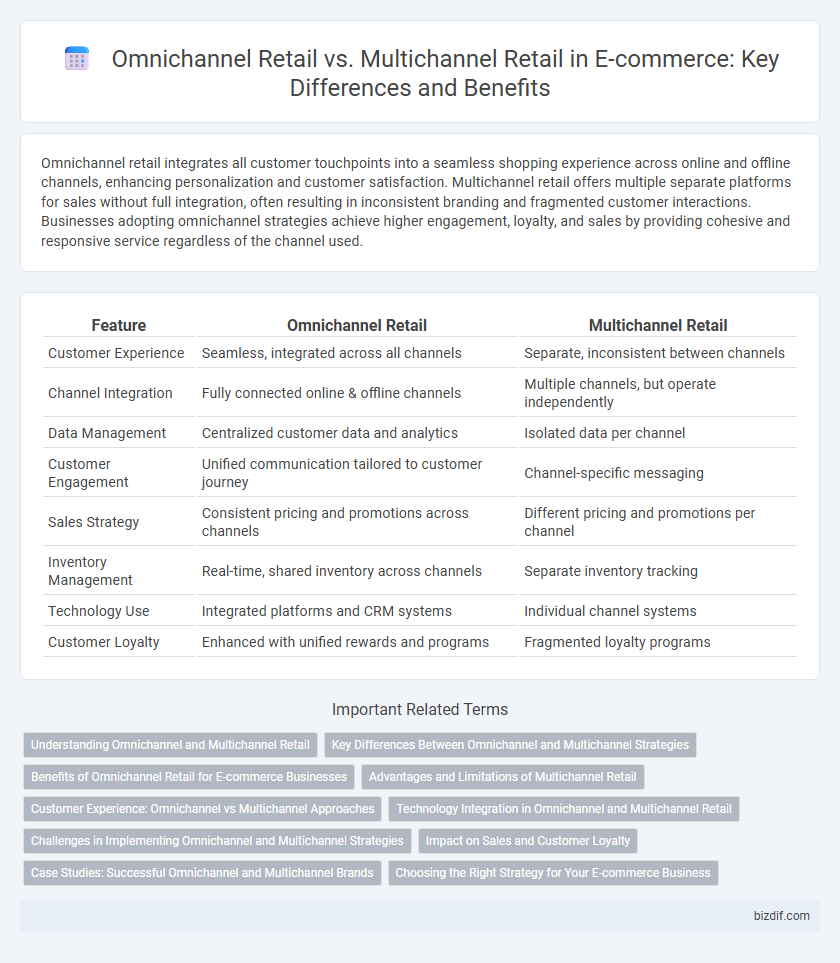Omnichannel retail integrates all customer touchpoints into a seamless shopping experience across online and offline channels, enhancing personalization and customer satisfaction. Multichannel retail offers multiple separate platforms for sales without full integration, often resulting in inconsistent branding and fragmented customer interactions. Businesses adopting omnichannel strategies achieve higher engagement, loyalty, and sales by providing cohesive and responsive service regardless of the channel used.
Table of Comparison
| Feature | Omnichannel Retail | Multichannel Retail |
|---|---|---|
| Customer Experience | Seamless, integrated across all channels | Separate, inconsistent between channels |
| Channel Integration | Fully connected online & offline channels | Multiple channels, but operate independently |
| Data Management | Centralized customer data and analytics | Isolated data per channel |
| Customer Engagement | Unified communication tailored to customer journey | Channel-specific messaging |
| Sales Strategy | Consistent pricing and promotions across channels | Different pricing and promotions per channel |
| Inventory Management | Real-time, shared inventory across channels | Separate inventory tracking |
| Technology Use | Integrated platforms and CRM systems | Individual channel systems |
| Customer Loyalty | Enhanced with unified rewards and programs | Fragmented loyalty programs |
Understanding Omnichannel and Multichannel Retail
Omnichannel retail integrates multiple sales channels into a seamless customer experience, enabling shoppers to transition effortlessly between online stores, mobile apps, and physical locations. Multichannel retail, by contrast, involves multiple separate channels that operate independently without unified customer data or consistent interactions. Understanding these distinctions is crucial for e-commerce businesses aiming to enhance customer engagement and streamline operations.
Key Differences Between Omnichannel and Multichannel Strategies
Omnichannel retail integrates all customer touchpoints to create a seamless shopping experience, combining online, in-store, mobile, and social channels into one unified platform. Multichannel retail operates multiple sales channels independently, often resulting in disconnected customer interactions and inconsistent branding. Key differences include omnichannel's focus on customer-centric integration and data synchronization versus multichannel's emphasis on channel variety without comprehensive coordination.
Benefits of Omnichannel Retail for E-commerce Businesses
Omnichannel retail enhances e-commerce businesses by providing a seamless and integrated customer experience across multiple channels, increasing customer engagement and loyalty. It enables real-time inventory management and unified customer data, improving personalization and operational efficiency. This approach boosts sales conversions and customer retention by offering consistent interactions whether customers shop online, via mobile apps, or in physical stores.
Advantages and Limitations of Multichannel Retail
Multichannel retail leverages multiple sales platforms, such as physical stores, online marketplaces, and social media shops, expanding reach and customer touchpoints while allowing targeted marketing strategies for each channel. However, it faces limitations in creating seamless customer experiences due to fragmented inventory management and inconsistent branding across channels. This disjointed approach often results in lower customer loyalty compared to omnichannel retail, which integrates all channels into a unified commerce ecosystem.
Customer Experience: Omnichannel vs Multichannel Approaches
Omnichannel retail delivers a seamless customer experience by integrating all channels--online, mobile, and physical stores--into a unified platform, enabling consistent interactions and personalized service. Multichannel retail offers multiple platforms for customer engagement but often operates in silos, leading to fragmented experiences and inconsistent messaging. Data from the National Retail Federation reveals that 73% of consumers prefer retailers with seamless omnichannel capabilities, highlighting its superior impact on customer satisfaction and loyalty.
Technology Integration in Omnichannel and Multichannel Retail
Omnichannel retail employs seamless technology integration across all platforms, unifying inventory management, customer data, and sales channels into a single system to enhance user experience and operational efficiency. Multichannel retail, conversely, operates multiple sales platforms independently, lacking the centralized technology that synchronizes customer interactions and backend processes. Advanced CRM software, real-time inventory tracking, and unified commerce platforms are key technological differentiators that empower omnichannel strategies to deliver cohesive and personalized shopper journeys.
Challenges in Implementing Omnichannel and Multichannel Strategies
Implementing omnichannel retail strategies presents challenges such as integrating real-time inventory data across multiple touchpoints, ensuring a seamless customer experience, and managing complex logistics in both online and offline channels. Multichannel retail struggles with inconsistent customer engagement and fragmented data systems that hinder personalized marketing and unified service delivery. Both approaches require significant investment in technology infrastructure and employee training to overcome operational silos and synchronization issues.
Impact on Sales and Customer Loyalty
Omnichannel retail integrates multiple sales channels to provide a seamless shopping experience, significantly boosting sales by meeting customers wherever they prefer to shop and ensuring consistent brand interactions. Multichannel retail operates through various separate channels, often leading to fragmented customer experiences and lower customer retention rates. Studies show omnichannel customers spend up to 30% more than single-channel counterparts, driving higher lifetime value and stronger customer loyalty.
Case Studies: Successful Omnichannel and Multichannel Brands
Brands like Nike and Sephora demonstrate the success of omnichannel retail by seamlessly integrating online platforms, physical stores, and mobile apps to enhance customer engagement and boost sales. In contrast, multichannel brands such as Walmart and Best Buy maintain separate channels with limited interaction, which can result in inconsistent customer experiences. Case studies reveal that omnichannel strategies lead to higher customer retention and increased revenue by providing a unified shopping journey.
Choosing the Right Strategy for Your E-commerce Business
Omnichannel retail integrates multiple customer touchpoints, including physical stores, online platforms, and mobile apps, creating a seamless shopping experience that boosts customer engagement and loyalty. Multichannel retail involves selling through several separate channels without integration, which may lead to inconsistent experiences and missed opportunities. Selecting an omnichannel approach for your e-commerce business enhances data synchronization and personalized marketing, leading to higher conversion rates and stronger customer retention.
Omnichannel Retail vs Multichannel Retail Infographic

 bizdif.com
bizdif.com